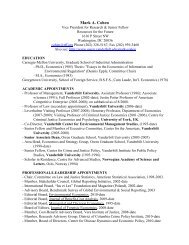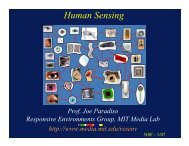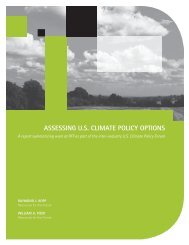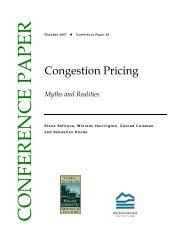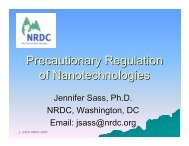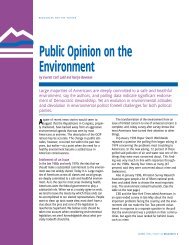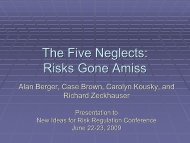Nanotechnology: Environmental Applications - Resources for the ...
Nanotechnology: Environmental Applications - Resources for the ...
Nanotechnology: Environmental Applications - Resources for the ...
You also want an ePaper? Increase the reach of your titles
YUMPU automatically turns print PDFs into web optimized ePapers that Google loves.
<strong>Nanotechnology</strong>:<br />
<strong>Environmental</strong> <strong>Applications</strong><br />
<strong>Resources</strong> <strong>for</strong> <strong>the</strong> Future<br />
First Wednesday Seminar Series<br />
Washington, D.C.<br />
June 6, 2007<br />
Marti Otto<br />
Office of Superfund Remediation and Technology Innovation<br />
U.S. <strong>Environmental</strong> Protection Agency<br />
Otto.martha@epa.gov
Outline<br />
• U.S. EPA and nanotechnology<br />
• <strong>Environmental</strong> applications<br />
• Outreach and publications<br />
2
U.S. EPA’s s Mission<br />
To Protect Human Health and<br />
<strong>the</strong> Environment<br />
Gallium Phosphide (GaP) Nanotrees<br />
(Prof. Lars Samuelson, Lund University, Sweden<br />
[Dick et al. 2004])<br />
Zinc oxide nanostructures syn<strong>the</strong>sized<br />
by a vapor-solid process. (Image courtesy of<br />
Prof. Zhong Win Lang of Georgia Tech<br />
3
The Challenge<br />
Use nanotechnology to:<br />
…Help clean up past environmental damage<br />
…Correct present environmental problems<br />
…Prevent future environmental impacts<br />
…Help sustain <strong>the</strong> planet <strong>for</strong> future generations<br />
4
Extramural Research At EPA<br />
<strong>Applications</strong><br />
• Address existing<br />
environmental problems<br />
or future environmental<br />
problems<br />
• Approximately $15.6 M as<br />
of January 2007<br />
www.sciencejobs.com<br />
Implications<br />
• Address <strong>the</strong> interactions of nanomaterials with <strong>the</strong><br />
environment and any potential risks that may be<br />
posed by nanotechnology<br />
• Approximately $17.6 M as of January 2007,<br />
excluding ultrafine<br />
5
EPA Extramural Research<br />
• Manufactured nanomaterials: physico-chemical<br />
principles of biocompatibility and toxicity<br />
– Joint research solicitation:<br />
NIEHS, NIOSH, NSF, EPA<br />
– Closed January 2007<br />
– $7 M<br />
• <strong>Environmental</strong> effects of manufactured nanomaterials<br />
– Joint research solicitation:<br />
DOE, NSF, EPA<br />
– Opened May 21, 2007; Closes August 22, 2007<br />
– $8 M to $9 M<br />
6
EPA Science to Achieve Results (STAR)<br />
<strong>Nanotechnology</strong> Grants<br />
Totals through January 2007<br />
$1,831,490<br />
$790,000 $774,626<br />
$2,393,000<br />
$7,184,159<br />
$3,433,394<br />
$4,564,000<br />
$6,795,203 $1,817,089<br />
Aerosol LCA Grn Man Remed Sensor Trtmnt Fate/Trn Tox Expos<br />
7
EPA and <strong>Nanotechnology</strong><br />
EPA <strong>Nanotechnology</strong> White Paper, February 15, 2007<br />
(available at http://www.epa.gov/OSA/nanotech.htm )<br />
• <strong>Environmental</strong><br />
benefits<br />
• Risk assessment<br />
• Responsible<br />
development<br />
• Research<br />
recommendations<br />
8
<strong>Environmental</strong> <strong>Applications</strong><br />
9
Diversity across classes of<br />
nanoscale materials<br />
Single and multi walled nanotubes<br />
Fullerenes<br />
Nanoshells<br />
Metal oxides<br />
Dendrimers<br />
Quantum dots<br />
Nanosomes<br />
10
<strong>Environmental</strong> <strong>Applications</strong> of<br />
<strong>Nanotechnology</strong><br />
• Treatment/Remediation<br />
• Sensors<br />
• Green Manufacturing<br />
• Energy<br />
11
<strong>Environmental</strong> <strong>Applications</strong>:<br />
Superfund Opportunities<br />
• Treatment/Remediation<br />
• Real-time monitoring<br />
and detection<br />
Macalloy Corp. Site, North Charleston, SC,<br />
1000th Superfund site completed<br />
12
<strong>Environmental</strong> <strong>Applications</strong>:<br />
Treatment/Remediation,<br />
Characterization and Monitoring<br />
• Sensors to detect chemical and biological<br />
agents<br />
• Nanofiltration <strong>for</strong> more efficient filters<br />
• Particles including zeolites, nanoscale<br />
magnetite, dendrimers, and tunable<br />
biopolymers to scavenge metals<br />
• Nanocomposites to remove metals from<br />
smokestack emissions<br />
• Nanoscale photocatalysts, nanoscale zerovalent<br />
iron, and polymeric nanoparticles to<br />
address organic contaminants<br />
13
<strong>Environmental</strong> <strong>Applications</strong>: Nanosized<br />
Iron <strong>for</strong> Groundwater Remediation<br />
<strong>Environmental</strong><br />
Science & Technology<br />
Wei-xian Zhang, Lehigh University<br />
<strong>Environmental</strong><br />
<strong>Nanotechnology</strong><br />
Smaller sized iron particles<br />
More complete reduction of<br />
chlorinated hydrocarbons<br />
PUBLISHED BY<br />
THE AMERICAN<br />
CHEMICAL SOCIETY<br />
14
<strong>Environmental</strong> <strong>Applications</strong>:<br />
Mercury Thiol-SAMMS<br />
A Nanoporous Functionalized Ceramic Support<br />
Shas Mattigod, Pacific Northwest National Laboratory<br />
15
<strong>Environmental</strong> <strong>Applications</strong>:<br />
Targeted Heavy Metal Binding<br />
Elastin Domain Metal Binding Domain<br />
Fine tune delta T by controlling amino acid<br />
sequence and no. of repeating unit (VPGXG) n<br />
Fine tune affinity<br />
with different<br />
binding<br />
sequence<br />
Utilization of a non-toxic polymer to bind heavy<br />
metals like arsenic in water or soil<br />
Wilfred Chen, University of CA, Riverside<br />
16
<strong>Environmental</strong> <strong>Applications</strong>:<br />
Monitoring and Detection<br />
Electrode<br />
connection<br />
Long shielded cable<br />
Quick disconnect<br />
environmentally-sealed<br />
connector<br />
PVC type housing<br />
Working electrode<br />
Counter electrode<br />
Reference electrode<br />
Remote electrochemical and bio-sensors<br />
J. Wang, Arizona State University<br />
17
<strong>Environmental</strong> <strong>Applications</strong>:<br />
Manufacturing<br />
• Possible improvements to manufacturing processes,<br />
reducing <strong>the</strong> amounts of materials needed<br />
– Improved catalytic converters: potential reduction<br />
by up to 95% of <strong>the</strong> amount of platinum group<br />
metals required<br />
– Lead-free conductive adhesives <strong>for</strong>med from selfassembled<br />
monolayers based on nanotechnology:<br />
potential replacement <strong>for</strong> lead solder<br />
• Organic light emitting diodes (OLEDs)<br />
– Potential display technology substitute <strong>for</strong> cathode<br />
ray tubes, which contain lead.<br />
18
<strong>Environmental</strong> <strong>Applications</strong>:<br />
Energy<br />
• Lighter materials <strong>for</strong> vehicles:<br />
increased fuel efficiency<br />
• Materials to increase efficiencies of<br />
electrical components and transmission lines<br />
• Nanomaterials arranged in superlattices that could<br />
allow <strong>the</strong> generation of electricity from waste heat<br />
in consumer appliances, automobiles, and<br />
industrial processes<br />
• Materials that could contribute to a<br />
new generation of photovoltaic cells<br />
and fuel cells<br />
Volkswagen Nanospider<br />
19
Outreach and Publications<br />
• Workshops on <strong>Nanotechnology</strong> <strong>for</strong> Site<br />
Remediation<br />
http://www.frtr.gov/nano<br />
http://esc.syrres.com/nanotech/<br />
• Issues area on CLU-IN website<br />
http://clu-in.org/nano<br />
• Series of Internet Seminars on Nano and Superfund<br />
http://clu-in.org/training<br />
• EPA ORD nanotechnology website<br />
http://es.epa.gov/ncer/nano/index.html<br />
• Upcoming Superfund fact sheet on nanotechnology<br />
<strong>for</strong> site remediation<br />
20
For More In<strong>for</strong>mation<br />
Marti Otto<br />
Technology Innovation and Field Services Division<br />
USEPA’s Office of Superfund Remediation<br />
and Technology Innovation<br />
703.603.8853<br />
Otto.martha@epa.gov<br />
21




